Study of low-temperature pyrolysis of oil shale: physicochemical properties and thermal decomposition products
Views: 402 / PDF downloads: 152
DOI:
https://doi.org/10.32523/2616-6771-2025-150-1-52-65Keywords:
pyrolysis processing, waste-free production, waste utilisation, oil sludge, pyrolysis oil, semi-cokeAbstract
One of the priority tasks of applied chemistry and chemical technology is the processing of oil sludge, which contributes to the reduction of emissions of oil and gas enterprises and their further use as valuable secondary raw materials. This paper deals with the study of pyrolysis processes of oil shale from the ‘Kenderlyk’ field, including the analysis of its physical and chemical properties and thermal decomposition products. The detailed elemental analysis was carried out and mineral composition of the feedstock was studied.
During the research parallel experiments on pyrolysis of oil shale were carried out, which allowed to determine quantitative yields of semi-coke, pyrolysis oil (tar) and combustible gas. The main characteristics of the products, such as their component composition, calorific value and other parameters important for further processing and use were analysed.
The obtained experimental data demonstrated stable product yields and confirm the possibility of effective use of pyrolysis in oil shale processing. The isolated products have high energy potential and can be used in various industries, including fuel and energy sector and metallurgy. Thus, oil shale processing by pyrolysis method seems to be a promising direction in the sphere of resource saving and environmental protection.
Downloads
References
Akbarova, E. (2024). Doklad Predsedatelya Komiteta geologii Ministerstva promyshlennosti I stroitel’stva RK. Elektron. Resur. https://www.gov.kz/memleket/entities/geology/press/news/details/902112?directionId=3783&lang=ru
Bhatt, M., Chakinala, A. G., Joshi, J. B., Sharma, A., Pant, K. K., Shah, K., & Sharma A. (2021). Valorization of solid waste using advanced thermo-chemical process: A review. Journal of Environmental Chemical Engineering, 4, 105434. https://doi.org/10.1016/j.jece.2021.105434
Chandran, R., Kaliaperumal, R., Balakrishnan, S., Britten, A. J., MacInnis, J., & Mkandawire, M. (2020). Characteristics of bio-oil from continuous fast pyrolysis of Prosopis juliflora. Energy, 190, 116387. https://doi.org/10.1016/J.ENERGY.2019.116387
Devi, P., & Saroha, A.K. (2014). Risk analysis of pyrolyzed biochar made from paper mill effluent treatment plant sludge for bioavailability and eco-toxicity of heavy metals. Bioresource Technology, 162, 308–315. https://doi.org/10.1016/j.biortech.2014.03.093
Dhyani, V., & Bhaskar, T. (2018). A comprehensive review on the pyrolysis of lignocellulosic biomass. Renewable Energy, 129, 695–716. https://doi.org/10.1016/j.renene.2017.04.035
Glazyrin, S. A., Aibuldinov, Y. K., Kopishev, E. E., Zhumagulov, M. G., & Bimurzina, Z. A. (2024). Analysis of the Composition and Properties of Municipal Solid Waste from Various Cities in Kazakhstan. Energies, 17(24), 6426. https://doi.org/10.3390/en17246426
Ishekenova, B. (2025). Kazahstane nashli bol’shie zapasy slancevoi nefti: dv kakih regionah ee hotyat dobyvat. Elektron. Resurs. https://lsm.kz/kazahstan-imeet-ser-eznye-zapasy-slancevoj-nefti
Marculescu, C., Antonini, G., Badea, A., & Apostol, T. (2007). Pilot installation for the thermo-chemical characterisation of solid wastes. Waste Management, 27(3), 367–374. https://doi.org/10.1016/j.wasman.2006.02.011
Nurgaliyev, N. U., Aibuldinov, Ye. K., Iskakova, Zh. B., Kolpek, A., Mashan, T. T., Kusepova, L. A., & Kopishev. E. Ye. (2024). Investigation of the kinetics of the coal pyrolysis process. Vestnik КаzUТB, 2, 280-289. https://doi.org/10.58805/kazutb.v.2.23-456
Nurgaliyev, N. U., Iskakova, Zh. B., Kolpek, A., Aibuldinov, Ye. K., Sabitov, A. S., Kopishev, E. Ye., Salihov, R. M., Petrov, М. S., Alzhanova, G. Zh., Abdiyusupov, G. G., & Omirzak, М. Т. (2024). Sovmestnyi piroliz nizkosortnogo topliva I prirodnogo bituma. Vestnik КаzUТB, 2, 215-225. https://doi.org/10.58805/kazutb.v.2.23-391
Nurgaliyev, N. U., Iskakova, Zh. B., Kolpek, A., Aibuldinov, Ye. K., Sabitov, A. S., Kopishev, E. Ye, Salihov, R. M., Petrov, М. S., Alzhanova, G. Zh., Abdiyusupov, G. G., & Omirzak, М. Т. (2024). Sovmestnyi piroliz nizkosortnogo topliva I prirodnogo bituma. Vestnik КаzUТB, 2, 215-225. https://doi.org/10.58805/kazutb.v.2.23-391
Nurgaliyev, N., Kolpek, A., Iskakova, Zh., Glazyrin, S., Safarov, R., & Aibuldinov, Ye. (2024). Low-temperature pyrolysis of coal with determination of physicochemical properties of coal and its thermal decomposition products. E3S Web of Conferences. ICSREE 2024, 545, 03004
Pyl, S. P., Van Geem, K. M., Puimège, P., Sabbe, M. K., Reyniers, M. F., & Marin, G. B. (2012). A comprehensive study of methyl decanoate pyrolysis. Energy. Elsevier Ltd., 43(1), 146–160. https://doi.org/10.1016/J.ENERGY.2011.11.032
Ramazanova, N. Y., Berdenov, Z. G., Ramazanov, S. K., Kazangapova, N. B., Romanova, S. M., Toksanbaeva, S. T., & Wendt, J. (2019). Landscape-geochemical analysis of steppe zone basin Zhaiyk. News of the National Academy of Sciences of the Republic of Kazakhstan (Series of Geology and Technical Sciences), 436, 33–41. https://doi.org/10.32014/2019.2518-170X.95.
Reyes-Rivera, J., Solano, E., Terrazas, T., Soto-Hernández, M., Arias, S., Almanza-Arjona, Y. C., & Polindara-García, L. A. (2020). Classification of lignocellulosic matrix of spines in Cactaceae by Py-GC/MS combined with omic tools and multivariate analysis: A chemotaxonomic approach. Journal of Analytical and Applied Pyrolysis, 148, 104796. https://doi.org/10.1016/j.jaap.2020.104796
Sabitov, A., Lopez, G., Mashan, T. T., Kusepova, L. A., Aibuldinov, Ye. K., & Kopishev, E. E. (2024). Investigation of oil shale pyrolysis process: Physicochemical properties and decomposition products. E3S Web Conf. 2024 9th International Conference on Sustainable and Renewable Energy Engineering (ICSREE 2024), 545, 03002. https://doi.org/10.1051/e3sconf/202454503002
Safarov, R. Z., Shomanova, Z. K., Mukanova, R. Z., Nossenko, Y. G., Alexandru, I., Sviderskiy, A. K., & Sarova, N. (2019). Design of neural network for forecast analysis of elements-contaminants distribution on studied territories (on example oF Pavlodar City, Kazakhstan). Series Chemistry and Technology (National Academy of Sciences of the Republic of Kazakshtan), 438, 86–98. https://doi.org/10.32014/2019.2518-1491.78.
Shandarin, V. D. (2016). Bezalternativnyi metod utilizacii uglerodsoderzhashih othodov – Nauchnoe obozrenie. Tehnicheskie nauki (nauchnyi zhurnal), 2, 71–74. https://science-engineering.ru/ru/article/view?id=1082
Sikhimbayeva, D., Zulkharnay, A., Zhakupov, A., Yessilov, A., & Kuttybay, M. (2021). Analysis of factors affecting to the development of sub-production industry of the Republic of Kazakhstan. Montenegrin Journal of Economics, 17(3), 41–57. https://doi.org/10.14254/1800-5845/2021.17-3.4
Sieradzka, M., Gao, N., Quan, C., Mlonka-Mędrala, A., & Magdziarz, A. (2020). Biomass thermochemical conversion via pyrolysis with integrated CO2 capture. Energies, 13(5). https://doi.org/10.3390/EN13051050
Sorum, L., Gronli, M. G., & Hustad, J. E. (2001). Pyrolysis characteristics and kinetics of municipal solid wastes. Fuel, 80(9), 1217–1227. https://doi.org/10.1016/S0016-2361(00)00218-0
Taboada-Ruiz, L., Pardo, R., Ruiz, B., Díaz-Somoano, M., Calvo, L. F., Paniagua, S., & Fuente, E. (2024). Progress and challenges in valorisation of biomass waste from ornamental trees pruning through pyrolysis processes. Prospects in the bioenergy sector. Environmental Research, 249, 118388. https://doi.org/10.1016/j.envres.2024.118388
Toshmamatov, B., Davlonov, K., Rakhmatov, O., & Toshboev, A. (2021). Recycling of municipal solid waste using solar energy. IOP Conference Series: Materials Science and Engineering, 1030(1), 012165. https://doi.org/10.1088/1757-899X/1030/1/012165
Veses, A., Sanahuja-Parejo, O., Callén, M. S., Murillo, R., & García, T. (2020). A combined two-stage process of pyrolysis and catalytic cracking of municipal solid waste for the production of syngas and solid refuse-derived fuels. Waste Management, 101, 171–179. https://doi.org/10.1016/j.wasman.2019.10.009
Downloads
Published
Issue
Section
License
Copyright (c) 2025 R. Salikhov, M. Petrov (Author)

This work is licensed under a Creative Commons Attribution-NonCommercial 4.0 International License.








